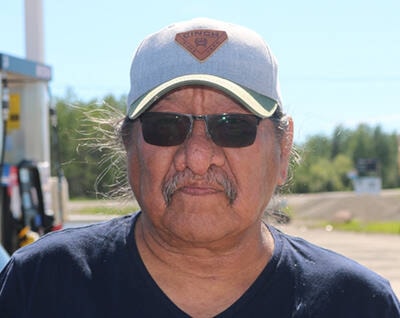Smith’s Landing Chief Gerry Cheezie worries that proposed federal regulations could allow the pollution of NWT waterways with toxic oil sands tailings from northern Alberta.
“We’re one of many communities that would be affected by this,” Cheezie said. “We’ll have to keep fighting against this crazy plan they have.
Smith’s Landing lies just south of Fort Smith in Alberta and along the Slave River, downstream from oil sands mines near the Athabasca River.
“(The mines) have been in operation for 40-plus years. In those years they’ve been emitting pollution into the atmosphere and into the water.”
Environment and Climate Change Canada (ECCC) spokesperson Samantha Bayard confirmed in an email that the government is developing Oil Sands Mining Effluent Regulations under the Fisheries Act to “reduce the need for new tailing ponds to store mine waste and accelerate the future reclamation of mining sites.”
The change comes as the volume of tailings and the risks of seepage from tailings ponds and floods increases. She said the regulations would “ensure” that authorized releases of effluent would only happen under strict quality standards to minimize environmental risks.
In January, ECCC launched a Crown-Indigenous Working Group comprising nine First Nations and Métis Nations in the Athabasca region to help ensure the effluent regulations are protective of the environment and address possible impacts to Indigenous rights from effluent releases, Bayard said.
Indigenous communities that aren’t part of the working group could also be engaged in the process.
Shane Thompson, minister of Environment and Natural Resources said in the Legislative Assembly on Dec. 7 that the GNWT is working to have a seat at the table in the negotiations over the regulations. He added that he doesn’t support the release of tailings into the environment.
Of the approximately 1.4 trillion litres of tailings consisting of water, sand and residual bitumen contained in ponds, there is evidence over the last decade that “processed water” from the ponds has seeped into nearby groundwater and possibly into rivers, according to a 2020 report from the Commission for Environmental Cooperation.
Current Alberta environmental regulations require tailings to be stored in the ponds for eventual reclamation and the federal Fisheries Act prohibits the release of any “deleterious substance” into waters where fish are present.
Although Smith’s Landing was expected to issue a news release on Monday outlining the First Nation’s work with the federal government on research into tailings, Cheezie stressed that lines of communication on the issue must remain open.
“We definitely would have a lot to say about this,” he said. “We want to be at the table when things are going to be discussed that will affect our way of life in such a negative way.”
Thompson, in an exchange with Frame Lake MLA Kevin O’Reilly said the GNWT is aware of the concerns of Indigenous communities and is trying to open conversations with the federal and Alberta governments.
“This has been a very long issue for…our Indigenous governments across the territories, all the way up from the Beaufort Delta all the way down to Fort Smith,” the minister said. “We’ve heard them. We are working with them within the system we have presently. We are communicating back and forth with a letter and there will be another letter being sent out probably within the next week or so.”
While the Mackenzie River Basin Transboundary Waters Agreement between the NWT, Alberta and British Columbia requires signatories to protect the waterways within the Mackenzie River Basin, Cheezie hopes the accord doesn’t become an excuse for inaction.
“The GNWT can’t hide behind the Transboundary Water Agreement and say ‘don’t worry everything is under control.’ We’ve got to get the GNWT to get off the fence and start to provide some leadership here and give some protection for their people and the rivers.”
